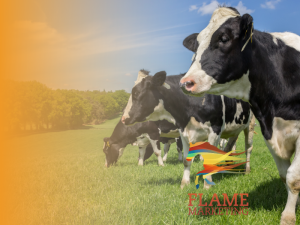

We have all seen the headlines of dairy farmers having to pour milk down the drain and the ongoing issues surrounding the price per litre of milk paid to dairy farms. Right now, it is extremely tough being a dairy farmer and even tougher to make a decent living at it. This is why so many dairy farms are now turning to dairy diversification to improve their income and help save their herds.
There is a huge range of farm diversification options for dairy farmers looking at new revenue streams. Dairy diversifications can range from simply selling milk direct to producing a full range of dairy products such as cheese, yoghurt and cream. You can check out some dairy diversification ideas here
The huge range of diversification options for dairy farms means it can be hard to choose one which is right for you. We recommend writing a long list of ideas and then doing some general research on each one before creating a shortlist which you can further explore. Try to examine the pros and cons of each dairy diversification option before making your shortlist. This might include financial questions such as the upfront costs versus the return on investment. Or it may include practicality issues such as location, planning permission, and skills required to make the project viable. We have covered some of these in this blog.
It is also worth considering how you may want to develop the diversification further, for example, you may decide to do multiple diversification projects which all link together. If this is the case consider how you can best plan these in stages so you are overwhelmed at the beginning. You may also be able to find others to work with collaboratively, for example, teaming up with a local cheesemaker to produce a jointly branded cheese as a partnership.
We often speak to farmers who are really excited about a specific farm diversification idea but haven’t properly considered the processes and logistics involved in their dream diversification. This is not to say we think this should put anyone off pursuing their ideal dairy diversification but it is important that you take the time to consider and plan how you are going to tackle any and all logistical issues.
For example, if you are looking to sell your products online through a website you will need to ask yourself the following questions:
This is not an exhaustive list and the list of questions will vary depending on what type of dairy diversification you are planning but it is worth taking the time to answer each of these questions before making a final decision on how you want to set up your farm diversification project.
You will likely also need to consider what infrastructure you require to support your new business; this includes physical infrastructure such as buildings, refrigeration and equipment but also digital or virtual infrastructure such as websites, order/stock systems and customer databases.
 If you are selling your products from a physical location such as from a farm shop or vending machine then you will also need to think about how customers will find you. Have you provided clear directions on your marketing material, have you invested in decent signage that will help customers to find you easily?
If you are selling your products from a physical location such as from a farm shop or vending machine then you will also need to think about how customers will find you. Have you provided clear directions on your marketing material, have you invested in decent signage that will help customers to find you easily?
When working with clients we do our absolute best to go beyond simply supporting them with their marketing needs and also look to provide advice and support on a full range of business needs. This is often through our expert consultants and strategic partners, for example, although we don’t produce signage in-house, we can refer you to a signage company we work with regularly and who are experts in their field. Simply ask us for what you are looking for and we will put you in touch.
Often a dairy diversification will involve some form of planning permission requirement, whether this be for a small milk vending machine shed or a much larger creamery and processing building. Whatever the case it is always worth making sure you are fully aware of any requirements, the likelihood of being granted the required changes and the cost of this.
I often see landowners, farmers and smallholders asking around on Facebook groups regarding if they require planning permission for this or that diversification option. Most of the comments in response are contradictory and the truth likely depends on your specific set-up, location and needs which is impossible to completely describe in a Facebook group. Instead, I would advise having an early no-obligation chat with a planning consultant or advisor. Ideally one with experience in gaining planning permission in your area and for your industry. We tend to refer clients to Acorus, James lives locally to us and have been very helpful in providing preliminary information for our clients in the past.

Once you have a good idea of the costs involved in your dairy diversification you need to consider how to best fund it. You may decide to choose a diversification that requires lower upfront costs in which case this can be self-funded but for most dairy diversification projects you will need some form of upfront investment.
There are currently a number of farm diversification grants which are either due to open soon or are in some form of pilot-stage. It is likely this will continue as farmers are moved from BPS to ELMS. With that in mind, it is worth doing your research to find out which grants you are eligible for and how many you can apply for to maximise your grant funding. When applying for grant funding you may find you are only able to gain funding for specific types of costs. However, it is worth speaking to an advisor to ensure you are applying for everything you can do. For example, many farmers don’t consider applying to fund related to marketing or professional costs but this can often be covered under ‘’productivity improvement’’ or ‘’digital development’’.
Once you have exhausted the grant funding options you may decide to consider some form of bank loan, once again make sure you include costs for professional and marketing expenses when working on how much funding you require. It is better to borrow a little too much than not enough. Alternative funding options include crowdfunding or investment companies. We often recommend clients speak to Folk2folk who specialise in funding for farm diversification projects.
Most potential clients I speak to only ever write a business plan if it is required for funding and even then, they likely never look at this again once it is sent off to the relevant funding provider. But a farm business plan can be  so much more than simply a tool to gain funding. A well-written farm business plan can help you to set goals for the business, and review its success in a tangible and objective way. It can also help to provide you with accountability, helping you to stay focused on your farm business development goals, rather than simply ticking along on auto-pilot. Your business plan also helps to ensure everyone in the family is on the same page and gives you a place to write down your expectations and processes for the business should you choose to.
so much more than simply a tool to gain funding. A well-written farm business plan can help you to set goals for the business, and review its success in a tangible and objective way. It can also help to provide you with accountability, helping you to stay focused on your farm business development goals, rather than simply ticking along on auto-pilot. Your business plan also helps to ensure everyone in the family is on the same page and gives you a place to write down your expectations and processes for the business should you choose to.
When preparing your farm business plan be sure to include detailed financial goals and cost projections as this will aid in your planning and also support any funding applications you may wish to do. If you are unsure about any aspect of preparing this, a good accountant or funding advisor should be able to help you with this.
You should also try to include a farm marketing strategy in your business plan, this will help to support your application for funding, will make it easier for a marketing consultant such as us to understand your goals, and will give you a road map to starting your marketing for the farm diversification. Think about who your ideal customer is, how you can target them, and what key messages you want to communicate to your customers. You should also consider what methods for marketing you wish to use and work in reasonable costs for these even if it’s a time cost rather than a monetary cost. If you need any advice on creating a farm marketing strategy you can book a free consultation with us, or check out our free farm marketing strategy guide download.
Once you have everything in place to get going on your dairy diversification you need to prepare for selling to the public. Think of this as your last-minute checks before you jump straight in. Once you start your farm diversification you are bound to learn on the way and change and adapt plans you started with. But if you can prepare as much as possible then you are far more likely to have a successful and profitable farm diversification from the start.
Start creating build-up and excitement for your farm business by doing some pre-launch marketing, tell local people about the new business, contact local magazines to see if you can gain some coverage, get posting on social media to get your followers going up, maybe even offer to add potential customers to a mailing list so they can find out as soon as the website is launched or the shop is open. This is all about building suspense and getting people interested before you even open the doors, if done right this will mean you get plenty of sales when you first open allowing you to build off that traction. You could even do a soft release/open where there is a limited number of products or orders before the proper full launch to road test your processes and create a sense of exclusivity.
Speaking of process testing make sure you have tested all the customer processes before you open, all those logistical questions at the start make sure your solutions for each of them are working smoothly before you open to the public. This might include training staff or family members on the processes, for example, working a till or packaging a product as you want it.
Remember we are always here to help and support our clients through every stage of their diversification journey.